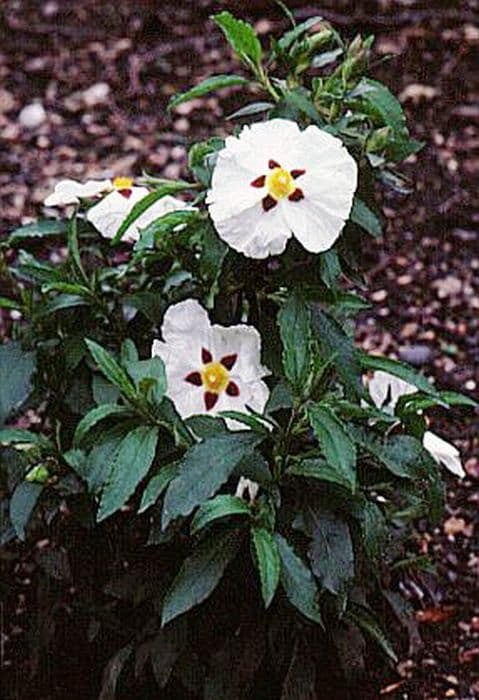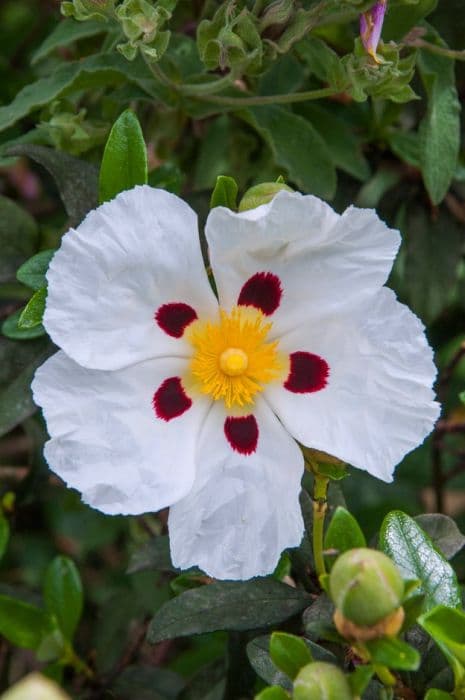Rock Rose Halimium ocymoides

ABOUT
Halimium ocymoides, commonly known as rock rose, is a flowering plant distinguished by its showy appearance. The plant is adorned with bright yellow flowers that are notably vibrant and eye-catching. These flowers have a saucer-like shape, radiating with a simplicity that is both charming and appealing. Each flower consists of five petals, which often feature a delicate pattern of reddish-brown spots at their base, creating an attractive contrast against the yellow background. The foliage of the rock rose presents a silvery-green hue, with leaves that are small, linear, and somewhat lance-shaped. These leaves can give the plant a slightly grayish tone, providing a beautiful backdrop for the brilliant yellow of the flowers. The leaves are arranged alternately along the stems, contributing to the overall bushy and dense appearance of the shrub. Rock rose blooms profusely during its flowering season, covering the plant in a blanket of yellow that is hard to miss in any garden setting where it is grown. Its showy display and complementary foliage make it a popular choice for ornamental purposes, adding a splash of color and Mediterranean charm to landscapes.
About this plant
 Names
NamesSynonyms
Rockrose, Hairy Rockrose
Common names
Cistus ocymoides, Halimium ocymoides var. lasianthum, Halimium viscosum, Helianthemum ocymoides.
 Toxicity
ToxicityTo humans
Halimium ocymoides, commonly known as rockrose, is not widely documented to be toxic to humans. There is a lack of specific information regarding the plant's toxicity and possible consequences of ingestion by humans. Due to the general lack of information, it is advisable to avoid ingesting any part of the rockrose plant and to keep it out of reach of children, who might be more sensitive to potential toxins.
To pets
Rockrose (Halimium ocymoides) does not have a well-documented record of toxicity to pets such as dogs and cats. However, due to the general lack of detailed information concerning its toxicity, it is prudent to prevent pets from ingesting any part of the rockrose plant. If a pet does consume part of the plant, monitoring for any signs of illness and consulting a veterinarian is recommended.
 Characteristics
CharacteristicsLife cycle
Perennials
Foliage type
Evergreen
Color of leaves
Green
Flower color
Yellow
Height
3 feet (0.91 meters)
Spread
5 feet (1.52 meters)
Plant type
Shrub
Hardiness zones
8
Native area
Mediterranean
Benefits
 General Benefits
General Benefits- Landscape Aesthetics: Halimium ocymoides, commonly known as Rock Rose, adds visual interest to gardens with its bright yellow flowers.
- Drought Resistance: Rock Rose is highly adaptable to dry conditions, making it ideal for water-wise landscaping.
- Wildlife Attraction: The blooms provide nectar for pollinators such as bees and butterflies, enhancing biodiversity.
- Low Maintenance: Rock Rose typically requires minimal care once established, reducing the need for frequent gardening intervention.
- Ground Cover: Its spreading habit makes it effective for soil stabilization and covering bare patches in the landscape.
- Seasonal Interest: With a prolonged flowering season, Rock Rose offers a vibrant display from spring to summer.
 Medical Properties
Medical Properties- This plant is not used for medical purposes.
 Air-purifying Qualities
Air-purifying QualitiesThis plant is not specifically known for air purifying qualities.
 Other Uses
Other Uses- Halimium ocymoides, commonly known as the rock rose, can be used as groundcover in gardens due to its low-growing habit and drought resistance, which makes it suitable for xeriscaping or dry garden areas.
- The rock rose's dense and bushy form provides excellent habitat for garden wildlife, such as small birds and insects, offering them shelter and a nesting area.
- With its bright yellow flowers, Halimium ocymoides can be planted alongside roadways and in public landscapes for ornamental purposes, adding color and visual interest to these environments.
- The plant can be used in coastal areas as it has a good tolerance to sea breezes and can contribute to stabilizing sandy soils and preventing erosion.
- Rock rose can also be incorporated into fire-resistant plantings as part of a fire-wise landscaping approach due to its ability to recover after low-intensity fires.
- Its woody stems allow the plant to be used in the crafting of rustic garden structures, such as trellises or informal fencing, blending well with naturalistic garden designs.
- As an evergreen shrub, Halimium ocymoides provides year-round greenery, making it a valuable plant for winter gardens when other plants may have lost their foliage.
- The flowering of the rock rose can be a source of nectar for bees and butterflies, making it a useful plant for pollinator gardens and for supporting local biodiversity.
- When planted en masse, the rock rose can create a striking visual effect with its silvery-green foliage and vibrant flowers, suitable for mass plantings in park settings or large gardens.
- Rock rose might occasionally be used in educational settings such as botanical gardens, where its adaptation to dry climates and specific morphology are valuable for ecological and botanical studies.
Interesting Facts
 Feng Shui
Feng ShuiThe Halimium is not used in Feng Shui practice.
 Zodiac Sign Compitability
Zodiac Sign CompitabilityThe Halimium is not used in astrology practice.
 Plant Symbolism
Plant Symbolism- Resilience: Halimium ocymoides, commonly known as Rockrose, is adapted to dry and rocky habitats, often symbolizing the ability to endure and thrive in harsh conditions.
- Beauty: The Rockrose's delicate flowers suggest appreciation of natural beauty, even amidst arid environments.
- Ephemerality: Since the flowers of the Rockrose often last for only a short time each day, they can represent the transient nature of life and beauty.
- Renewal: Rockroses can recover quickly after wildfires, thus symbolizing renewal, hope, and the cycle of rebirth after destruction or adversity.
 Water
WaterThe Rock Rose should be watered deeply, ensuring the soil is moistened thoroughly. It's essential to allow the soil to dry out between watering to prevent root rot. For young plants, watering might be necessary once or twice a week, but well-established plants are drought-tolerant and may require less frequent watering. During hot summer months, provide the Rock Rose with roughly 1 gallon of water every week if there has been no significant rainfall. In cooler temperatures or when established, water can be reduced to every two to three weeks.
 Light
LightThe Rock Rose thrives best in full sunlight, which means it should receive at least six hours of direct sun daily. The ideal spot for this plant is in a south-facing garden, where it can soak up ample sunlight. Avoid too much shade, as this can impede the plant's bloom and overall health.
 Temperature
TemperatureRock Roses are resilient in a variety of temperature conditions and can withstand temperatures as low as 10 degrees Fahrenheit. However, they prefer warmer climates and optimum growth occurs between 60 and 75 degrees Fahrenheit. Protect them from extreme cold and frost, which might damage the plant.
 Pruning
PruningPruning Rock Roses helps maintain their shape and encourages bushier growth with more flowers. Prune in late winter or early spring before new growth starts. Deadheading spent blooms throughout the growing season can also promote additional flowering. Typically, light annual pruning is enough, cutting back by a third.
 Cleaning
CleaningAs needed
 Soil
SoilThe best soil mix for Halimium, commonly known as Rockrose, is well-draining with added grit or sand. A slightly acidic to neutral pH, around 5.5 to 7.5, is ideal for Rockrose.
 Repotting
RepottingRockrose should be repotted every few years or as needed when it outgrows its container, typically every 2 to 3 years.
 Humidity & Misting
Humidity & MistingRockrose prefers low to moderate humidity levels and is quite drought-tolerant once established.
 Suitable locations
Suitable locationsIndoor
Ensure full sun exposure & well-draining soil for indoor Rockrose.
Outdoor
Plant Rockrose in full sun, well-draining soil; tolerates drought.
Hardiness zone
7-10 USDA
 Life cycle
Life cycleHalimium ocymoides, commonly known as Rockrose, starts its life cycle as a seed, which under proper conditions germinates in late winter to early spring. The seedling develops into a young plant with characteristic hairy, gray-green foliage. As the plant matures, it enters the vegetative stage, characterized by the growth of stems and leaves, preparing for the reproductive phase. Flowering occurs in late spring to summer, showcasing yellow flowers with a dark maroon spot at the base of each petal, which are pollinated by insects. After pollination, the plant produces dry, capsule-like fruits, containing seeds that are dispersed by wind or animals. Rockrose is a perennial, surviving for several years and going through the flowering and seed-setting stages annually.
 Propogation
PropogationPropogation time
Spring
Propogation: The most popular method for propagating Halimium ocymoides, also known as rockrose, is by semi-hardwood cuttings. This technique is commonly performed in late summer when new growth has partially matured and stems are neither too soft nor too woody. To propagate, select healthy, disease-free growth and make a cutting about 4 to 6 inches long. Strip off the lower leaves, dip the cut end in rooting hormone to enhance root development, and plant the cutting in a well-draining potting mix. The pot should then be placed in a warm area with bright, indirect light and kept moist until roots develop, generally within a few weeks. Ensuring a high humidity environment can be beneficial, which can be maintained by covering the pot with a plastic bag or a humidity dome.









